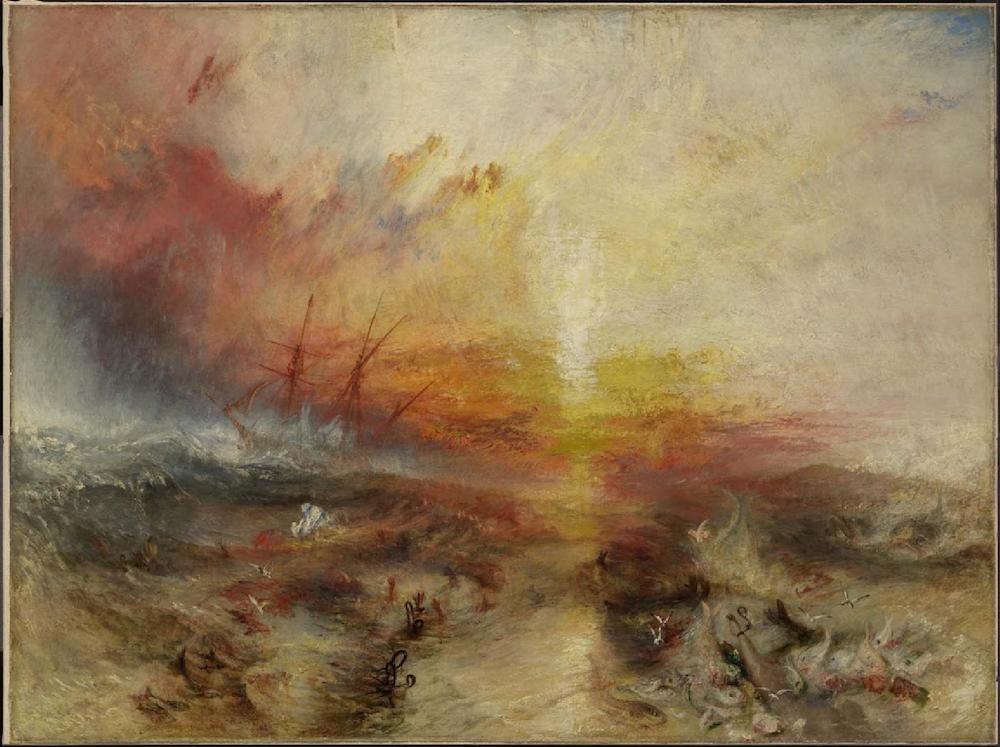
J. M. W. Turner, Slave Ship. [Full title: Slavers Overthrowing the Dead and Dying — Typho[o]n Coming On.] Oil on Canvas. 90.8 cm high by 122.6 cm wide (35 ¾ by 48 ¼ inches). First shown at the annual exhibition of the Royal Academy of Arts in 1840. Collection: Museum of Fine Arts, Boston. Accession no. 99.22. [Detail of chains and hands in the ocean.]
As the museum's own commentary explains, when Turner composed some lines of poetry for the catalogue of the original exhibition, he was only following his usual practice. But the lines are hard-hitting:
Aloft all hands, strike the topmasts and belay;
Yon angry setting sun and fierce-edge clouds
Declare the Typhon's coming.
Before it sweeps your decks, throw overboard
The dead and dying — ne'er heed their chains
Hope, Hope, fallacious Hope!
Where is thy market now? [qtd. in Hamerton 288]
This is not just another painting of a shipwreck. The victims here were in chains, their plight as "unheeded" as their helplessness, and their treatment by their fellow-men even more disturbing than the suffering inflicted by the gathering storm. The word "market" at the end takes on a particular significance when the full context is known: Turner is referring to an actual incident in 1781, when the captain of a British slaver deliberately threw overboard 132 of the dead or dying who constituted his human cargo, in order to claim insurance for "items" which had now become unsaleable.
The museum's commentary describes the scene vividly, showing how the artist captured "the horror of the event and the terrifying grandeur of nature through hot, churning color and light that merge sea and sky." Philip Hamerton, in his early biography of Turner, also draws attention to the horror of the scene, this time in the depiction of the victims: "The introduction of the sharks, manacles, and human hand and leg, was artistically awkward to manage, and is so horrible that the mind revolts from these details" (289).
When shown in America, the work was controversial, to say the least. Hamerton quotes one American artist, George Innes, as saying that it was "the most infernal piece of clap-trap ever painted" (qtd. 289). But John Ruskin, who was the first owner of the work, had quite a different opinion, and his verdict on it has been vindicated by the judgment of time. The museum commentary includes part of his appreciation of it from Chapter III, section 5 of Modern Painters, but it is worth reading the passage in full:
I believe, if I were reduced to rest Turner’s immortality upon any single work, I should choose this. Its daring conception — ideal in the highest sense of the word — is based on the purest truth, and wrought out with the concentrated knowledge of a life; its color is absolutely perfect, not one false or morbid hue in any part or line, and so modulated that every square inch of canvas is a perfect composition; its drawing as accurate as fearless; the ship buoyant, bending, and full of motion; its tones as true as they are wonderful; and the whole picture dedicated to the most sublime of subjects and impressions — (completing thus the perfect system of all truth, which we have shown to be formed by Turner’s works) — the power, majesty, and deathfulness of the open, deep, illimitable Sea. [572-73]
The dreadful inhumanity of the episode was not lost on Ruskin. Just before this, he had described the ship as "guilty" (572). But here, in the section of his book entitled "Of Water, as Painted by Turner," Ruskin is concerned with the elemental rather than the human, and with bringing out Turner's tremendous skill in depicting it.
Related Material
- The Slave Ship in the context of the imagery of shipwrecks and castaways
- Review of Stephen J. May's Voyage of the Slave Ship: J. M. W. Turner's Masterpiece in Historical Context (2014)
- Marjie Bloy, The Anti-Slavery Campaign in Britain
- Review of Turner's Modern World (Tate exhibition of 2020/21)
Image believed by the Museum to be in the public domain. Text and formatting by Philip Allingham and Jacqueline Banerjee.
Bibliography
Hamerton, Philip Gilbert. The Life of J.M.W. Turner, RA. London: Seeley, Jackson, & Halliday. 1879. Internet Archive, from a copy in Cornell University Archive. Web. 26 April 2025.
Ruskin, John. The Works of John Ruskin. Edited by E.T. Cook and Alexander Wedderburn. London: George Allen, 1903. Internet Archive, from a copy in Trent University. Web. 26 April 2025.
"Slave Ship (Slavers Throwing Overboard the Dead and Dying, Typhoon Coming On). MFABoston Accessed 24 April 2025. Http://collections.mfa.org/objects/31102.
Created 9 September 2015
Last modified 23 April 2025